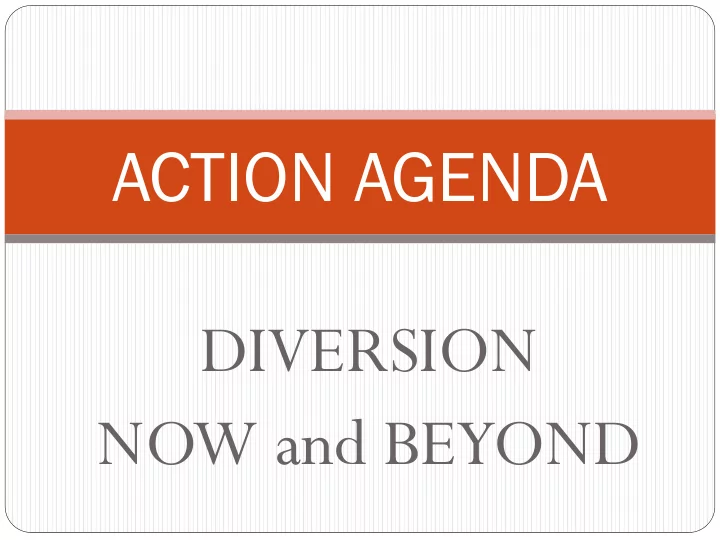

ACTION AGENDA DIVERSION NOW and BEYOND
What is Diversion? A strategy that helps people identify and access alternatives to entering shelter to resolve their immediate housing crisis and avoid homelessness. Is a service to help people avoid a shelter stay and resolve their immediate housing crisis Is not a denial or barrier to shelter entry and instead expands options to identify alternatives to shelter – National Alliance to End Homelessness
Wit ithin t in the Div Diversion ion Pr Proce cess …. Creative Problem Solving Conversation to Identify Solutions to Immediate Housing Crisis Connections to Family and Natural Supports Conflict Resolution/Mediation Landlord/Tenant Mediation Strengths-Based Case Management Housing Search/Placement Connection to Mainstream Resources
Whe When S Shou hould Y You ou Use se Di Diversion Strat ategie ies? – National Alliance to End Homelessness
Why Div y Diver ersion? ion? Reduces new entries into homelessness Cuts down on number of clients waiting to get into shelter Stems inflow into the shelter system Reduces demand for limited shelter beds Improves system performance outcomes by reducing new entries and re-entries into homelessness Targets more intensive homelessness interventions and resources to be provided to those with higher needs who have no alternatives to a shelter stay
Diversion Workgroup Purpose Working with the Coordinated Entry System (CES), provide a roadmap for effective and appropriate shelter diversion activities which will quickly connect individuals and families with alternate housing arrangements and services.
Current nt P Pil ilots Family Diversion Pilot SSVF Rapid Resolution Pilot Eviction Diversion Pilot
Family ly D Diversion on P Pilo lot WHO: The Salvation Army emergency homeless assessment and response center (EHARC) or Shield of Hope provides families in crisis an assessment, compassionate support, and a referral to the program that best meets their immediate needs, including living with family or friends, shelter or other temporary arrangement. WHAT: Mini-diversion assessment for families that may be placed directly into shelter from the field and are not stepping into the facility. When: Began August 6, 2018 As of October 31, 2018 – 14 families have been diverted - 8 with Mediation, 6 with financial assistance for rent, travel or furniture
SS SSVF RAPI RAPID RE RESO SOLUTION WHO: SSVF Providers at the Community Resource and Referral Center (CRRC) WHAT: The SSVF Rapid Resolution Pilot focuses on a diversion within the veteran population. The goal of the Pilot Project is to gather information about effective rapid resolution (diversion, rapid exit, reunification, creative housing, etc.) practices including the amount and type of financial assistance that contributes to a resolution of the housing crisis. Quantitative data is being gathered from Homeless Management and Information System (HMIS) and other sources to analyze the process and outcomes of Rapid Resolution. This information will inform the anticipated national implementation of Rapid Resolution by SSVF in early 2019. When: Since it’s launch on July 6, 2018, SSVF providers have enrolled 4 veterans into Rapid Resolution and have had a total of 9 conversations. Types of financial assistance include rental assistance, transportation vouchers or utilituy assistance and groceries.
Evict iction ion Div Diversio ion Prog ogram WHO: The Eviction Diversion Program is a Continuum of Care initiative led by the Lawyers’ Committee for Better Housing. WHAT: The Eviction Diversion Program (EDP) helps tenants facing a short-term crisis avoid a harmful eviction judgment through resolution services, case management, and emergency financial assistance. In addition, the EDP educates stakeholders about the costs of and alternatives to eviction. By facilitating mutually beneficial agreements between tenants and landlords, the EDP will unburden the court and shelter system by stabilizing housing for individuals at-risk of homelessness. Both tenants and landlords can be referred to the program through a an eviction court judge or clerk. In order to increase accessibility for potential clients, the court has provided a space in the Richard J. Daley Center. When: Began October 1, 2018 – Since its launch approximately 11 referrals have been received and of those eleven, 6 have qualified for the program.
State H Homele less P Prevention on F Funds (SHP (SHPF) State government funds Cover security deposits, rent, mortgages, and utilities up to $2,500 during a two-year period Payments are made directly to landlords or vendors 8 partner agencies provide eligibility determination and case management services Anyone needing financial assistance can dial 3-1-1 and ask for “Short Term Help” to get screened for a referral Impact: In FY 18, $1,535,252.00 was distributed to 982 households.
You outh Div Diver ersion ion Currently provided and funded by Catholic Charities – Diversion Specialist The Youth line of work within the Action Agenda The Youth Diversion Work Group held 3 peer to peer conversation with Austin, Seattle and Minneapolis. Modeling youth diversion in Chicago after Seattle’s approach Youth and adult supporter define success and goals for permanency Diverting youth should positively impact program outcomes Evaluation method should be included as part of program design Strong, clear evaluation supports advocacy for additional resources Communicating outcome promotes support within the system Training is key to diversion success
You outh Div Diver ersion ion
The B e Beyond Creating diversion as a possibility system-wide At access points or “front doors” to the homeless system Coordinated entry system access points Shelters Other places people are seeking homeless services assistance Training for within the CoC on Diversion Financial Resources
Recommend
More recommend